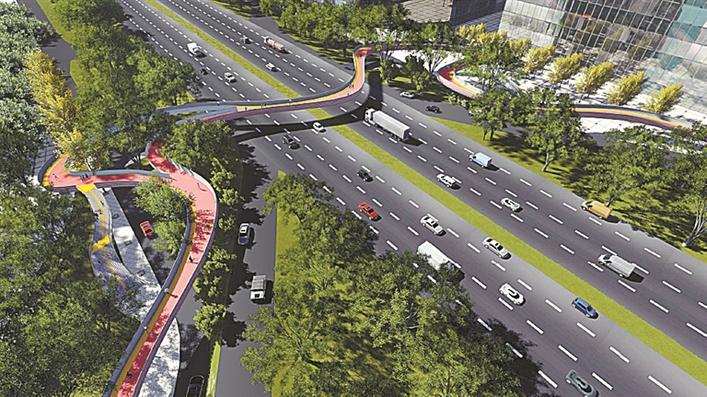City unveils slow traffic development plan
Writer: Han Ximin | Editor: Holly Wang | From: Shenzhen Daily | Updated: 2020-09-28

A computer-generated image of an elevated bicycle lane to be built across Beihuan Boulevard. DT News
Shenzhen will form a slow traffic network backboned by six new high-quality bicycle expressways and 12 trunk cycling roads, according to a development plan for 2021-2035 released by the city’s transportation bureau recently.
A bicycle traffic light system will be first piloted on artery roads such as Shennan Boulevard and Bao’an Boulevard, the plan indicated. The bicycle expressways, estimated to be 5-7 meters in width, are for bicycle use only, separated from pedestrian paths, and the trunk cycling roads are for bike and pedestrian mixed use.
By 2025, more than 35 percent of roads across the city will have bicycle lanes and the number will be increased to 50 percent by 2035, as per the plan.
To meet the demand of cyclists for long-distance commuting, Shenzhen has initiated cross-district bike lane construction, which will also meet the demand for health benefits and sports events, to encourage more commuters who drive a short distance to work to turn to bicycles. It will speed up the construction of Longhua-Futian and Longhua-Nanshan cross-district bicycle paths, and start the planning of the bicycle lanes that link Kuichong and Dapeng, Shekou and Liuxiandong, Futian and Luohu districts, and Yantian and Longgang districts.
Sightseeing-themed bicycle lanes are planned along the Maozhou River, coastal lines, parks and mountains in Long-hua, Guangming and Bao’an districts.
Parks and tourist attractions with bicycles lanes will open to riders in due course. Cyclists can make reservations to ride at Shenzhen Bay Park and Shenzhen Fairy Lake Botanical Garden during holidays and weekends. Bicycle parks are also being planned.
Shenzhen aims to become a bicycle-friendly city, where by 2035 about 10-15 percent of commuters will use bicycles and 10-13 percent of Metro riders will use bicycles as the tool to shuttle between Metro stations and other transportation means. By 2025, all newly built roads will have bicycle lanes.
An earlier report released by the bureau said the commuting distance of local residents is about 8.5 kilometers on average. Of them, 65 percent commute within a distance of 8 kilometers, and 51 percent commute between 2 and 8 kilometers. Bicycles have advantages for passengers traveling between 0.5 and 5 kilometers.
By the end of 2019, the city had 1,759 kilometers of bicycle lanes, about 14 percent of the overall length of urban roads. Eighty percent of bicycle lanes are shared with pedestrians without separating barriers.